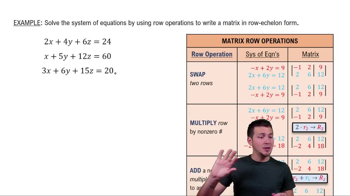Table of contents
- 0. Review of Algebra4h 16m
- 1. Equations & Inequalities3h 18m
- 2. Graphs of Equations43m
- 3. Functions2h 17m
- 4. Polynomial Functions1h 44m
- 5. Rational Functions1h 23m
- 6. Exponential & Logarithmic Functions2h 28m
- 7. Systems of Equations & Matrices4h 6m
- 8. Conic Sections2h 23m
- 9. Sequences, Series, & Induction1h 19m
- 10. Combinatorics & Probability1h 45m
7. Systems of Equations & Matrices
Introduction to Matrices
Problem 29f
Textbook Question
Find the partial fraction decomposition for each rational expression. See Examples 1–4. (2x^5 + 3x^4 - 3x^3 - 2x^2 + x)/(2x^2 + 5x + 2)
 Verified step by step guidance
Verified step by step guidance1
Step 1: Check if the degree of the numerator is greater than the degree of the denominator. If it is, perform polynomial division to reduce the degree of the numerator. In this case, the degree of the numerator (5) is greater than the degree of the denominator (2), so we need to perform polynomial division.
Step 2: After performing the polynomial division, you will get a quotient and a remainder. The quotient will be a polynomial, and the remainder will be a polynomial of degree less than the denominator.
Step 3: Write the original rational expression as the sum of the quotient and the remainder divided by the denominator. This is the first step in the partial fraction decomposition.
Step 4: Now, factor the denominator of the fraction obtained in step 3. In this case, the denominator is a quadratic polynomial, so you can factor it into two linear factors.
Step 5: Write the fraction as a sum of fractions, where each fraction has one of the factors of the denominator as its denominator. The coefficients of these fractions are unknowns that you will need to solve for. Set up a system of equations by equating the coefficients of like terms on both sides of the equation, and solve this system to find the unknowns. These unknowns are the coefficients of the partial fractions.
Recommended similar problem, with video answer:
 Verified Solution
Verified SolutionThis video solution was recommended by our tutors as helpful for the problem above
Video duration:
11mPlay a video:
Was this helpful?
Key Concepts
Here are the essential concepts you must grasp in order to answer the question correctly.
Rational Expressions
A rational expression is a fraction where both the numerator and the denominator are polynomials. Understanding rational expressions is crucial for performing operations like addition, subtraction, and decomposition. In this context, the expression (2x^5 + 3x^4 - 3x^3 - 2x^2 + x)/(2x^2 + 5x + 2) is a rational expression that needs to be decomposed into simpler fractions.
Recommended video:
Guided course

Rationalizing Denominators
Partial Fraction Decomposition
Partial fraction decomposition is a method used to express a rational function as a sum of simpler fractions. This technique is particularly useful for integrating rational functions or simplifying complex expressions. The goal is to break down the original rational expression into components that are easier to work with, typically involving linear or irreducible quadratic factors in the denominator.
Recommended video:

Decomposition of Functions
Polynomial Long Division
Polynomial long division is a process used to divide one polynomial by another, similar to numerical long division. This technique is essential when the degree of the numerator is greater than or equal to the degree of the denominator. In the context of partial fraction decomposition, performing polynomial long division may be necessary to simplify the rational expression before applying the decomposition method.
Recommended video:
Guided course

Introduction to Polynomials

 4:35m
4:35mWatch next
Master Introduction to Matrices with a bite sized video explanation from Patrick Ford
Start learningRelated Videos
Related Practice











